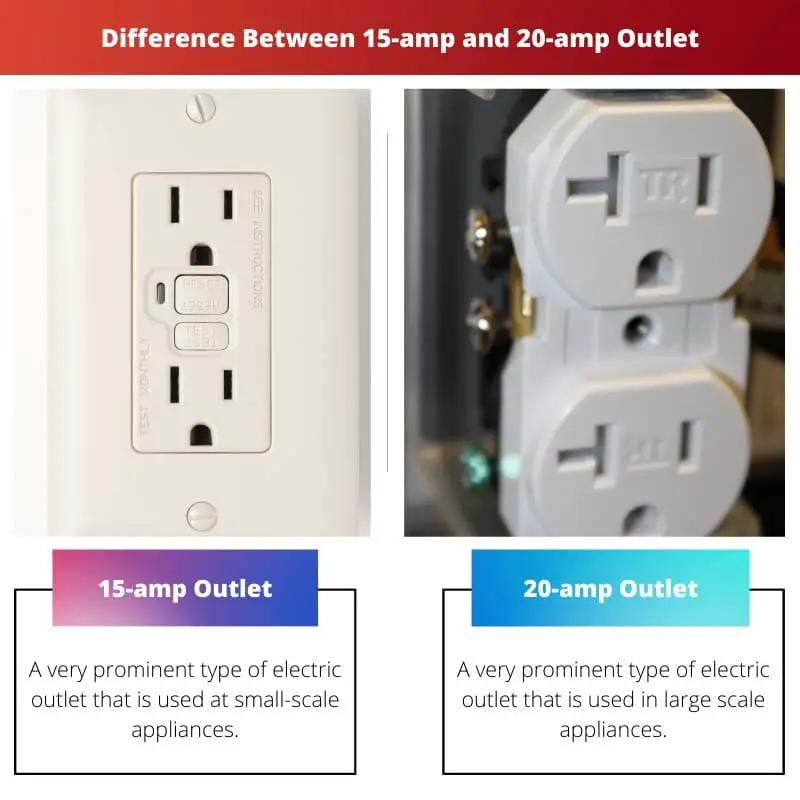Two electric outlets, namely a 15-amp outlet and 20-amp Outlet, are very popular all across the world, and while these two are used by many people interchangeably, they still carry a lot of differences.
It becomes very important to distinguish between these two as they are very important elements of our daily life.
Key Takeaways
- 15-amp outlets are designed to handle a maximum load of 15 amps, while 20-amp outlets can handle up to 20 amps.
- 20-amp outlets have a horizontal slot, while 15-amp outlets have a vertical slot.
- 20-amp outlets are required in certain areas, such as kitchens and bathrooms, where larger appliances may be used.
15- vs 20-amp Outlet
A 15Amp outlet can handle 1,800 Watts of power. Small to medium-sized appliances like lamps, computers, and small power tools can be powered by the 15 Amp Outlet. In contrast, you can draw up to 2,400 Watts from a 20Amp outlet. The majority of kitchen appliances and large machinery require a 20Amp outlet.

The 15-amp electric outlet happens to be very common all across the world, and it is widely used in places where the utilization happens to be minimal to moderate.
This outlet can be recognized very easily as the electric holes in this outlet appear as rectangles. A unique feature of this outlet is that this is not just compatible with a 15-amp outlet but a 20-amp outlet also.
But on the other hand, the 20-amp outlet happens to be very popular due to the fact that it can easily make itself compatible with large electrical appliances. This outlet can easily be found in places where the utilization of electricity is very high such as washing machines and refrigerators.
A unique feature that helps to recognize this outlet is that it contains a pin on the left of its corner with the shape of the letter T. The only drawback is that this outlet happens to be compatible with only a 20-amp outlet and not with a 15-amp outlet.
Comparison Table
| Parameters of Comparison | 15-amp Outlet | 20-amp Outlet |
|---|---|---|
| Meaning | A very prominent type of electric outlet that is used at small-scale appliances. | a very prominent type of electric outlet that is used in large scale appliances |
| Structure | this outlet contains one or two main holes along with a principal hole with the shape of the letter U. | this outlet contains 2 principal holes in the shape of the letter T at the very left corner. |
| Purpose | This outlet satisfies small scale power consumption uses | this outlet satisfies large-scale power consumption uses such as industry level uses. |
| Compatibility | this outlet happens to be compatible with a 15-amp outlet and a 20-amp outlet as well | this outlet happens to be compatible with a 20-amp outlet only |
| Popularity | this outlet is more popular as it offers much compatibility | this outlet is less popular as it offers less compatibility |
| Found with | this outlet is majorly found being used with small appliances like television etc. | This outlet is majorly found being used with large appliances like refrigerators and washing machines etc. |
What is 15-amp Outlet?
A 15-amp outlet, also known as the 15-ampere outlet, happens to be a very prominent type among all the electric outlets available in the public domain.
The reason behind this popularity is that this supported almost all the small-scale appliances available in our person’s house and happened to be very compatible and easy to use.
Usually, this outlet comes in two major types. One happens to be a two-prong outlet, and the other happens to be a three-prong outlet. In the very first one, there exists a primary hole along with the principal hole resembling the shape of the letter U.
And in the second one, there exist two primary holes along with one principal hole with the shape of the letter U. The major reason behind the popularity of this outlet is that it happens to be compatible with a 20-amp outlet as well.
This simply implies that it can be used with a 20-amp outlet also. Generally, this outlet is used with small-scale appliances such as a television and a computer, etc.

What is 20-amp Outlet?
A 20-amp outlet, popularly known as a 20-ampere outlet, is a type of electric outlet that has made an entrance in the market of electric appliances in the past ten years. With the changes in time and the utilization of the electric industry, this particular outlet made its debut and became very popular in a very short span of time.
This appears as a horizontal outlet with two pins present at the left corner of it, resembling the shape of the letter T of the English language. However, a major drawback with this outlet is that it can only be used with a 20-amp outlet only, and it is not compatible with any other outlook.
In most cases, this outlet is used at places where large electric appliances are deployed. These appliances include refrigerators, washing machines, microwaves, heavy machines, etc. Due to its lack of compatibility with other outlets, it is rarely used in households and is mostly used in industry-based properties.

Main Differences Between 15- and 20-amp Outlet
- A 15-amp outlet happens to be more compatible with small-scale appliances, while a 20-amp outlet happens to be more compatible with large-scale appliances.
- A 15-amp outlet contains a principal hole with the shape of the letter U while the 20-amp outlet contains two principal holes in the shape of the letter T at every left corner.
- The 15-amp outlet satisfies the needs of small appliances, while the 20-amp outlet satisfies the need of large appliances.
- A 15-amp outlet might be compatible with a 20-amp outlet as well, but as far as a 20-amp outlet is concerned, it only happens to be compatible with itself.
- A 15-amp outlet happens to be more popular due to its compatibility. Violet’s 20-amp outlet happens to be less popular.

- https://electrical.theiet.org/media/1688/the-origin-of-the-bs-1363-plug-and-socket-outlet-system.pdf
- https://www.sciencedirect.com/science/article/pii/S1361920909000935

The practical and detailed explanations of the 15-amp and 20-amp outlets assist readers in making informed decisions about their electrical installations and equipment. The focus on distinguishing these outlets is incredibly valuable.
Absolutely, Lola. The information presented here helps individuals in understanding and leveraging the 15-amp and 20-amp outlets for their specific electrical requirements.
Indeed, Lola. Increased awareness about the outlets’ specifications and uses can lead to better electrical management and safety measures.
The description of the 15-amp and 20-amp outlets, along with their distinct characteristics and uses, offers valuable information for those needing to distinguish between the two. The article certainly enhances the readers’ understanding of these electrical fixtures.
Indeed, Evans. The practical aspects discussed here assist readers in identifying and selecting the suitable outlets for their specific electrical devices.
The article distinguishes the 15-amp and 20-amp outlets effectively, highlighting their specific use cases and compatibilities. It is important for individuals to recognize and adapt to the correct outlet type for different electrical needs.
Well-stated, Bhall. The practical implications of understanding these outlets contribute to efficient and safe electrical installations and operations.
Absolutely, Bhall. This article encourages informed decision-making and responsible use of electrical outlets for various appliances and equipment.
The information about the structural and functional differences between the 15-amp and 20-amp outlets is essential for electrical professionals and homeowners alike. It’s key to know when and where to use each type to avoid problems and accidents.
Well said, Watson. I appreciate how this article emphasizes the importance of using the right outlet for specific applications. Knowing the load capacity of each outlet can prevent electrical overloads and faults.
The comparison table is particularly useful as it clearly outlines the differences in structure, purpose, and compatibility between the 15-amp and 20-amp outlets. This information can help individuals who are not well-versed in electrical systems understand the priorities of each outlet.
I agree, Ross. This comparison table simplifies the technical aspects of the outlets and provides a clear understanding of their applications.
Definitely, Ross. The direct comparison of the outlets makes it easier for various users to comprehend and utilize the outlets more effectively.
The detailed explanations of the 15-amp and 20-amp outlets provide valuable knowledge for homeowners, particularly when it comes to choosing the right outlet for small or large appliances. Understanding the compatibility and limitations of each outlet is crucial for electrical planning and management.
I completely agree, Keith. This article helps consumers understand the technical specifications and intended uses of various outlets, which is essential for the safety and efficiency of electrical systems.
Absolutely, Keith. The insights provided here enable individuals to make well-informed decisions about the electrical outlets they use in their homes and workplaces.
The clarity provided on the primary differences and applications of the 15-amp and 20-amp outlets contributes to an informed approach to electrical installations. It’s essential for users and professionals to have a comprehensive understanding of these outlets.
Certainly, Gordon. This article promotes the importance of considering the electrical requirements of different appliances and equipment to ensure safe and efficient usage.
The detailed insights on the 15-amp and 20-amp outlets are beneficial in guiding electrical users and installers toward appropriate usage and installation practices. It provides the necessary understanding of load capacities and outlet compatibilities.
Completely agree, Suzanne. This article serves as a valuable resource for individuals seeking to optimize their electrical systems by choosing the right outlets for various appliances and devices.
The difference and compatibility of the 15-amp and 20-amp outlets are crucial information for every homeowner and electrician. The ability to understand the correct usage of these outlets can save time, money, and energy. It’s important to ensure proper installation and use of each outlet as needed.
Indeed, the technical details provided in this article will help the readers appreciate the importance of using the right outlet for specific applications.
Absolutely Stacey! Understanding the difference and knowing the appropriate use of these outlets can prevent safety hazards and equipment damage.
The comprehensive portrayal of the features and utilities of the 15-amp and 20-amp outlets contributes to an enhanced understanding of their roles in electrical systems. The article is instrumental in educating readers on the significance of these outlets.
Absolutely, Eturner. The in-depth comparison and descriptions provided here will enable individuals to make informed choices regarding their outlet installations and applications.